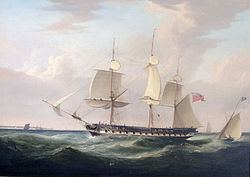Name Kent Tons burthen 1332, or 1421 ⁄94 (bm) | Type East Indiaman Launched 6 December 1820 | |
 | ||
Owner Stewart Marjoribanks (principal managing owner) Builder Wigram & Green, Blackwall Fate Lost in a fire at sea 1825 | ||
The Kent was an East Indiaman, a vessel sailing for the British East India Company, and launched in 1820. She completed two voyages to Bombay and China for the Company and was on her third voyage, to Bengal and China, when a fire in the Bay of Biscay destroyed her. Her captain for all three voyages was Henry Cobb.
Contents
Voyages 1 & 2
Kent left Cowes on 14 March 1821 and reached Bombay on 10 June. She arrived in Singapore on 29 August, and Whampoa anchorage on 24 September. On her return leg she crossed the Second Bar on 29 December. She reached St Helena on 2 May 1822, and arrived at The Downs on 27 June.
On her second voyage, Kent left The Downs on 7 January 1823, reaching New Anchorage on 9 May. From there she reached Penang on 1 August and Singapore on 21 August. A little more than a month later, on 30 September, she arrived at Whampoa. Kent crossed the Second Bar on 16 November, reached St Helena on 7 February 1824, and arrived back at The Downs on 22 March.
Third voyage
Kent left the Downs on 19 February 1825 with 20 officers and 344 soldiers belonging to the 31st Regiment of Foot, 43 women and 66 children, 20 private passengers, and a crew (including officers) of 148 men. In all, there were 641 persons on board.
Loss
A report from 1832 states:
THE SHIP ON FIRE,
Rescue
By chance the brigantine Cambria saw Kent's distress signal. Cambria, a small vessel bound for Mexico with a crew of 11 men, was transporting some 20 Cornish miners. The crew and miners worked tirelessly to rescue survivors, fully cognizant of the risk that the Kent's magazine might explode at any time. There were instances of men who tied the children of brother soldiers on their backs, and leaping overboard swam with their burdens to the boats. By the following evening, Cambria had some 550 survivors aboard her.
The crew of the ill-fated Kent unfortunately did not behave as well as the miners or soldiers. They refused to return for their shipmates after the first trip until the captain of the Cambria threatened not to let them board unless they did so.
At 2 a.m. the Kent did explode. Two hours after she blew up, a soldier's wife gave birth on board Cambria. The following morning Caroline rescued 14 of the men who remained on the wreck and carried them to Liverpool. Cambria landed her survivors back in Falmouth three days later. The miners and others associated with the rescue received silver medals in recognition of their courage and efforts.
Casualty list
Eighty-one people lost their lives: 54 soldiers, one woman, 20 children, one seaman, and five boys.
Portrayal
The loss of the ship became a subject for marine paintings, notably by William Daniell and by Théodore Gudin.
The Kent in art and literature
The loss of the Kent was highly newsworthy and led a number of artists to paint their own versions of the tragedy. In addition to William Daniell, artists that dealt with the tragedy included Théodore Gudin, Thomas Marie Madawaska Hemy (1874–1931), and an anonymous lithographer whose "Loss of the Kent" is in the National Maritime Museum, as are a number of other renditions. (The National Maritime Museum Cornwall has an aquatint of Daniell's painting.) Thomas Buttersworth (1768–1842) also painted "The East Indiaman Kent on Fire in the Bay of Biscay".
The loss of the Kent was later commemorated in a poem by William McGonagall.
